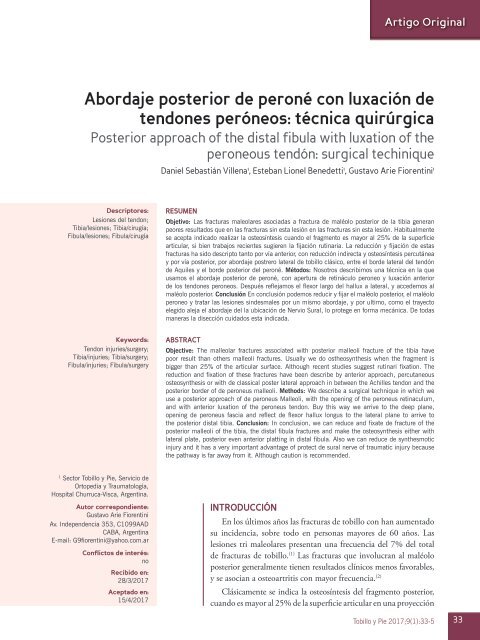Tobillo y Pie 9.1
Create successful ePaper yourself
Turn your PDF publications into a flip-book with our unique Google optimized e-Paper software.
Artigo Original<br />
Abordaje posterior de peroné con luxación de<br />
tendones peróneos: técnica quirúrgica<br />
Posterior approach of the distal fibula with luxation of the<br />
peroneous tendón: surgical techinique<br />
Daniel Sebastián Villena 1 , Esteban Lionel Benedetti 1 , Gustavo Arie Fiorentini 1<br />
Descriptores:<br />
Lesiones del tendon;<br />
Tibia/lesiones; Tibia/cirugía;<br />
Fibula/lesiones; Fibula/cirugía<br />
RESUMEN<br />
Objetivo: Las fracturas maleolares asociadas a fractura de maléolo posterior de la tibia generan<br />
peores resultados que en las fracturas sin esta lesión en las fracturas sin esta lesión. Habitualmente<br />
se acepta indicado realizar la osteosíntesis cuando el fragmento es mayor al 25% de la superficie<br />
articular, si bien trabajos recientes sugieren la fijación rutinaria. La reducción y fijación de estas<br />
fracturas ha sido descripto tanto por vía anterior, con reducción indirecta y osteosíntesis percutánea<br />
y por vía posterior, por abordaje postrero lateral de tobillo clásico, entre el borde lateral del tendón<br />
de Aquiles y el borde posterior del peroné. Métodos: Nosotros describimos una técnica en la que<br />
usamos el abordaje posterior de peroné, con apertura de retináculo peroneo y luxación anterior<br />
de los tendones peroneos. Después reflejamos el flexor largo del hallux a lateral, y accedemos al<br />
maléolo posterior. Conclusión En conclusión podemos reducir y fijar el maléolo posterior, el maléolo<br />
peroneo y tratar las lesiones sindesmales por un mismo abordaje, y por ultimo, como el trayecto<br />
elegido aleja el abordaje del la ubicación de Nervio Sural, lo protege en forma mecánica. De todas<br />
maneras la disección cuidados esta indicada.<br />
Keywords:<br />
Tendon injuries/surgery;<br />
Tibia/injuries; Tibia/surgery;<br />
Fibula/injuries; Fíbula/surgery<br />
ABSTRACT<br />
Objective: The malleolar fractures associated with posterior malleoli fracture of the tibia have<br />
poor result than others malleoli fractures. Usually we do ostheosynthesis when the fragment is<br />
bigger than 25% of the articular surface. Although recent studies suggest rutinari fixation. The<br />
reduction and fixation of these fractures have been describe by anterior approach, percutaneous<br />
osteosynthesis or with de classical poster lateral approach in between the Achilles tendon and the<br />
posterior border of de peroneus malleoli. Methods: We describe a surgical technique in which we<br />
use a posterior approach of de peroneus Malleoli, with the opening of the peroneus retinaculum,<br />
and with anterior luxation of the peroneus tendon. Buy this way we arrive to the deep plane,<br />
opening de peroneus fascia and reflect de flexor hallux longus to the lateral plane to arrive to<br />
the posterior distal tibia. Conclusion: In conclusion, we can reduce and fixate de fracture of the<br />
posterior malleoli of the tibia, the distal fibula fractures and make the osteosynthesis either with<br />
lateral plate, posterior even anterior platting in distal fibula. Also we can reduce de synthesmotic<br />
injury and it has a very important advantage of protect de sural nerve of traumatic injury because<br />
the pathway is far away from it. Although caution is recommended.<br />
1<br />
Sector <strong>Tobillo</strong> y <strong>Pie</strong>, Servicio de<br />
Ortopedia y Traumatología,<br />
Hospital Churruca-Visca, Argentina.<br />
Autor correspondiente:<br />
Gustavo Arie Fiorentini<br />
Av. Independencia 353, C1099AAD<br />
CABA, Argentina<br />
E-mail: G9fiorentini@yahoo.com.ar<br />
Conflictos de interés:<br />
no<br />
Recibido en:<br />
28/3/2017<br />
Aceptado en:<br />
15/4/2017<br />
INTRODUCCIÓN<br />
En los últimos años las fracturas de tobillo con han aumentado<br />
su incidencia, sobre todo en personas mayores de 60 años. Las<br />
lesiones tri maleolares presentan una frecuencia del 7% del total<br />
de fracturas de tobillo. (1) Las fracturas que involucran al maléolo<br />
posterior generalmente tienen resultados clínicos menos favorables,<br />
y se asocian a osteoartritis con mayor frecuencia. (2)<br />
Clásicamente se indica la osteosíntesis del fragmento posterior,<br />
cuando es mayor al 25% de la superficie articular en una proyección<br />
<strong>Tobillo</strong> y <strong>Pie</strong> 2017;9(1):33-5 33


